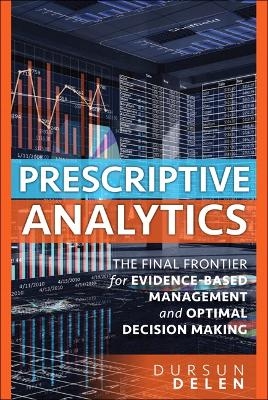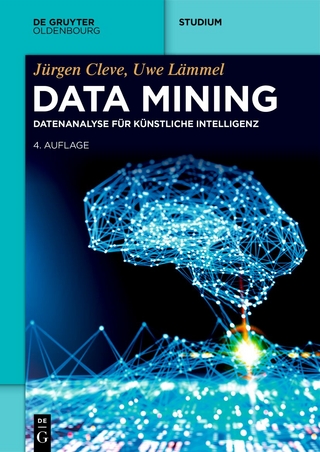
Prescriptive Analytics
Pearson FT Press (Verlag)
978-0-13-438705-5 (ISBN)
Prescriptive analytics is more directly linked to successful decision-making than any other form of business analytics. It can help you systematically sort through your choices to optimize decisions, respond to new opportunities and risks with precision, and continually reflect new information into your decisioning process.
In Prescriptive Analytics, analytics expert Dr. Dursun Delen illuminates the field’s state-of-the-art methods, offering holistic insight for both professionals and students. Delen’s end-to-end, all-inclusive approach covers optimization, simulation, multi-criteria decision-making methods, inference- and heuristic-based decisioning, and more. Balancing theory and practice, he presents intuitive conceptual illustrations, realistic example problems, and real-world case studies–all designed to deliver knowledge you can use.
Discover where prescriptive analytics fits and how it improves decision-making
Identify optimal solutions for achieving an objective within real-world constraints
Analyze complex systems via Monte-Carlo, discrete, and continuous simulations
Apply powerful multi-criteria decision-making and mature expert systems and case-based reasoning
Preview emerging techniques based on deep learning and cognitive computing
Dursun Delen, PhD, is the holder of the William S. Spears Endowed Chair in Business Administration, Patterson Family Endowed Chair in Business Analytics, Director of Research for the Center for Health Systems Innovation, and Regents Professor of Management Science and Information Systems in the Spears School of Business at Oklahoma State University (OSU). He received his PhD in Industrial Engineering and Management from OSU in 1997. Prior to his appointment as an Assistant Professor at OSU in 2001, he worked for a privately owned research and consultancy company, Knowledge Based Systems Inc., in College Station, Texas, as a research scientist for five years, during which he led a number of decision support, information systems, and advanced analytics-related research projects funded by federal agencies including DoD, NASA, NIST, and DOE. Dr. Delen provides professional education and consultancy services to companies and government agencies on analytics and information systems-related topics. He is often invited to national and international conferences for invited talks and keynote addresses on topics related to data/text mining, business intelligence, decision support systems, business analytics, and knowledge management. He served as the general co-chair for the 4th International Conference on Network Computing and Advanced Information Management in Seoul, South Korea, and regularly chairs tracks and mini-tracks at various business analytics and information systems conferences. He has published more than 150 peer-reviewed articles. His research has appeared in major journals, including Decision Sciences, Decision Support Systems, Communications of the ACM, Computers and Operations Research, Computers in Industry, Journal of Production Operations Management, Artificial Intelligence in Medicine, and Expert Systems with Applications. He recently authored/co-authored ten books/textbooks within the broad areas of business analytics, decision support systems, data/text mining, and business intelligence. He is the editor-in-chief for the Journal of Business Analytics, AI in Business, and International Journal of Experimental Algorithms, senior editor for Decision Support Systems and Decision Sciences, associate editor for Journal of Business Research, Decision Analytics, and International Journal of RF Technologies, and is on the editorial boards of several other academic journals.
Preface xii
Chapter 1 Introduction to Business Analytics and Decision-Making 1
Data and Business Analytics 1
An Overview of the Human Decision-Making Process 4
Simon’s Theory of Decision-Making 5
An Overview of Business Analytics 21
Why the Sudden Popularity of Analytics? 22
What Are the Application Areas of Analytics? 23
What Are the Main Challenges of Analytics? 24
A Longitudinal View of Analytics 27
A Simple Taxonomy for Analytics 31
Analytics Success Story: UPS’s ORION Project 36
Background 37
Development of ORION 38
Results 39
Summary 40
Analytics Success Story: Man Versus Machine 40
Checkers 41
Chess 41
Jeopardy! 42
Go 42
IBM Watson Explained 43
Conclusion 47
References 47
Chapter 2 Optimization and Optimal Decision-Making 49
Common Problem Types for LP Solution 51
Types of Optimization Models 52
Linear Programming 52
Integer and Mixed-Integer Programming 52
Nonlinear Programming 53
Stochastic Programming 54
Linear Programming for Optimization 55
LP Assumptions 56
Components of an LP Model 58
Process of Developing an LP Model 59
Hands-On Example: Product Mix Problem 60
Formulating and Solving the Same Product-Mix Problem in Microsoft Excel 68
Sensitivity Analysis in LP 72
Transportation Problem 76
Hands-On Example: Transportation Cost Minimization Problem 76
Network Models 81
Hands-On Example: The Shortest Path Problem 82
Optimization Modeling Terminology 89
Heuristic Optimization with Genetic Algorithms 92
Terminology of Genetic Algorithms 93
How Do Genetic Algorithms Work? 95
Limitations of Genetic Algorithms 97
Genetic Algorithm Applications 98
Conclusion 98
References 99
Chapter 3 Simulation Modeling for Decision-Making 101
Simulation Is Based on a Model of the System 106
What Is a Good Simulation Application? 110
Applications of Simulation Modeling 111
Simulation Development Process 113
Conceptual Design 114
Input Analysis 114
Model Development, Verification, and Validation 115
Output Analysis and Experimentation 116
Different Types of Simulation 116
Simulation May Be Dynamic (Time-Dependent) or Static (Time-Independent) 117
Simulations May Be Stochastic or Deterministic 118
Simulations May Be Discrete and Continuous 118
Monte Carlo Simulation 119
Simulating Two-Dice Rolls 120
Process of Developing a Monte Carlo Simulation 122
Illustrative Example–A Business Planning Scenario 125
Advantages of Using Monte Carlo Simulation 129
Disadvantages of Monte Carlo Simulation 129
Discrete Event Simulation 130
DES Modeling of a Simple System 131
How Does DES Work? 135
DES Terminology 138
System Dynamics 143
Other Varieties of Simulation Models 149
Lookahead Simulation 149
Visual Interactive Simulation Modeling 150
Agent-Based Simulation 151
Advantages of Simulation Modeling 153
Disadvantages of Simulation Modeling 154
Simulation Software 155
Conclusion 158
References 159
Chapter 4 Multi-Criteria Decision-Making 161
Types of Decisions 164
A Taxonomy of MCDM Methods 165
Weighted Sum Model 170
Hands-On Example: Which Location Is the Best for Our Next Retail Store? 172
Analytic Hierarchy Process 173
How to Perform AHP: The Process of AHP 176
AHP for Group Decision-Making 184
Hands-On Example: Buying a New Car/SUV 185
Analytics Network Process 190
How to Conduct ANP: The Process of Performing ANP 194
Other MCDM Methods 201
TOPSIS 202
ELECTRE 202
PROMETHEE 204
MACBETH 205
Fuzzy Logic for Imprecise Reasoning 207
Illustrative Example: Fuzzy Set for a Tall Person 208
Conclusion 210
References 210
Chapter 5 Decisioning Systems 213
Artificial Intelligence and Expert Systems for Decision-Making 214
An Overview of Expert Systems 222
Experts 222
Expertise 223
Common Characteristics of ES 224
Applications of Expert Systems 228
Classical Applications of ES 228
Newer Applications of ES 229
Structure of an Expert System 232
Knowledge Base 233
Inference Engine 233
User Interface 234
Blackboard (Workplace) 234
Explanation Subsystem (Justifier) 235
Knowledge-Refining System 235
Knowledge Engineering Process 236
1 Knowledge Acquisition 237
2 Knowledge Verification and Validation 239
3 Knowledge Representation 240
4 Inferencing 241
5 Explanation and Justification 247
Benefits and Limitations of ES 249
Benefits of Using ES 249
Limitations and Shortcomings of ES 253
Critical Success Factors for ES 254
Case-Based Reasoning 255
The Basic Idea of CBR 255
The Concept of a Case in CBR 257
The Process of CBR 258
Example: Loan Evaluation Using CBR 260
Benefits and Usability of CBR 260
Issues and Applications of CBR 261
Conclusion 266
References 267
Chapter 6 The Future of Business Analytics 269
Big Data Analytics 270
Where Does the Big Data Come From? 271
The Vs That Define Big Data 273
Fundamental Concepts of Big Data 276
Big Data Technologies 280
Data Scientist 282
Big Data and Stream Analytics 284
Deep Learning 289
An Introduction to Deep Learning 291
Deep Neural Networks 295
Convolutional Neural Networks 296
Recurrent Networks and Long Short-Term Memory Networks 301
Computer Frameworks for Implementation of Deep Learning 304
Cognitive Computing 308
How Does Cognitive Computing Work? 310
How Does Cognitive Computing Differ from AI? 311
Conclusion 312
References 313
Index 315
| Erscheinungsdatum | 12.10.2018 |
|---|---|
| Verlagsort | NJ |
| Sprache | englisch |
| Maße | 154 x 230 mm |
| Gewicht | 460 g |
| Themenwelt | Informatik ► Datenbanken ► Data Warehouse / Data Mining |
| Informatik ► Office Programme ► Outlook | |
| Mathematik / Informatik ► Mathematik ► Finanz- / Wirtschaftsmathematik | |
| Wirtschaft ► Betriebswirtschaft / Management ► Logistik / Produktion | |
| Wirtschaft ► Betriebswirtschaft / Management ► Unternehmensführung / Management | |
| Wirtschaft ► Volkswirtschaftslehre ► Ökonometrie | |
| ISBN-10 | 0-13-438705-8 / 0134387058 |
| ISBN-13 | 978-0-13-438705-5 / 9780134387055 |
| Zustand | Neuware |
| Informationen gemäß Produktsicherheitsverordnung (GPSR) | |
| Haben Sie eine Frage zum Produkt? |
aus dem Bereich


